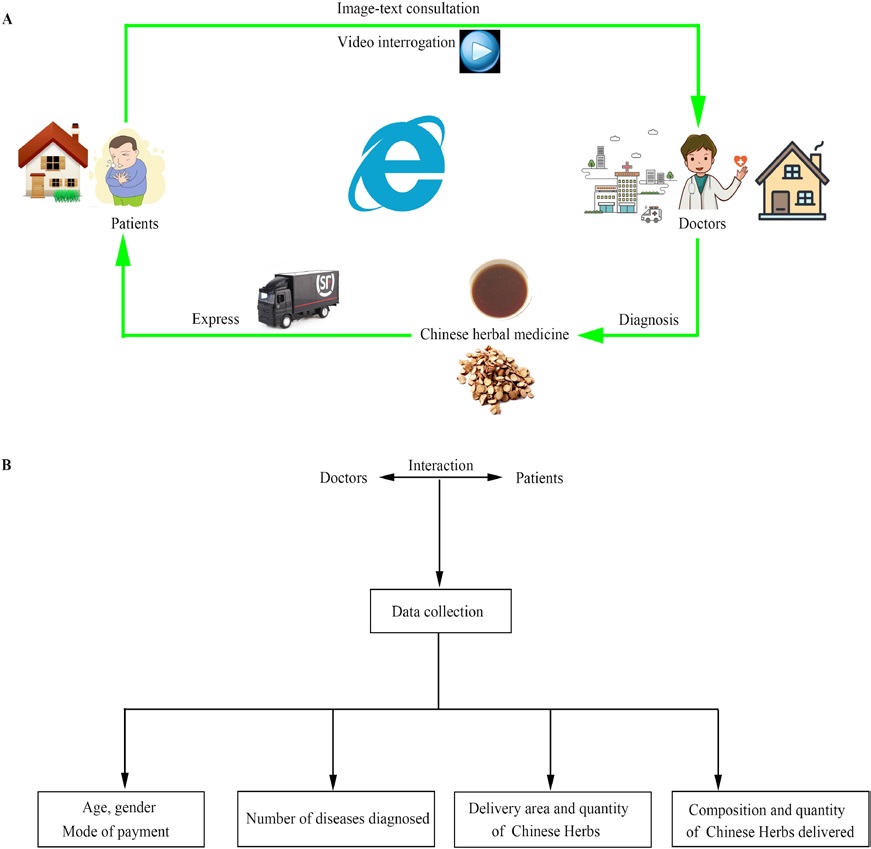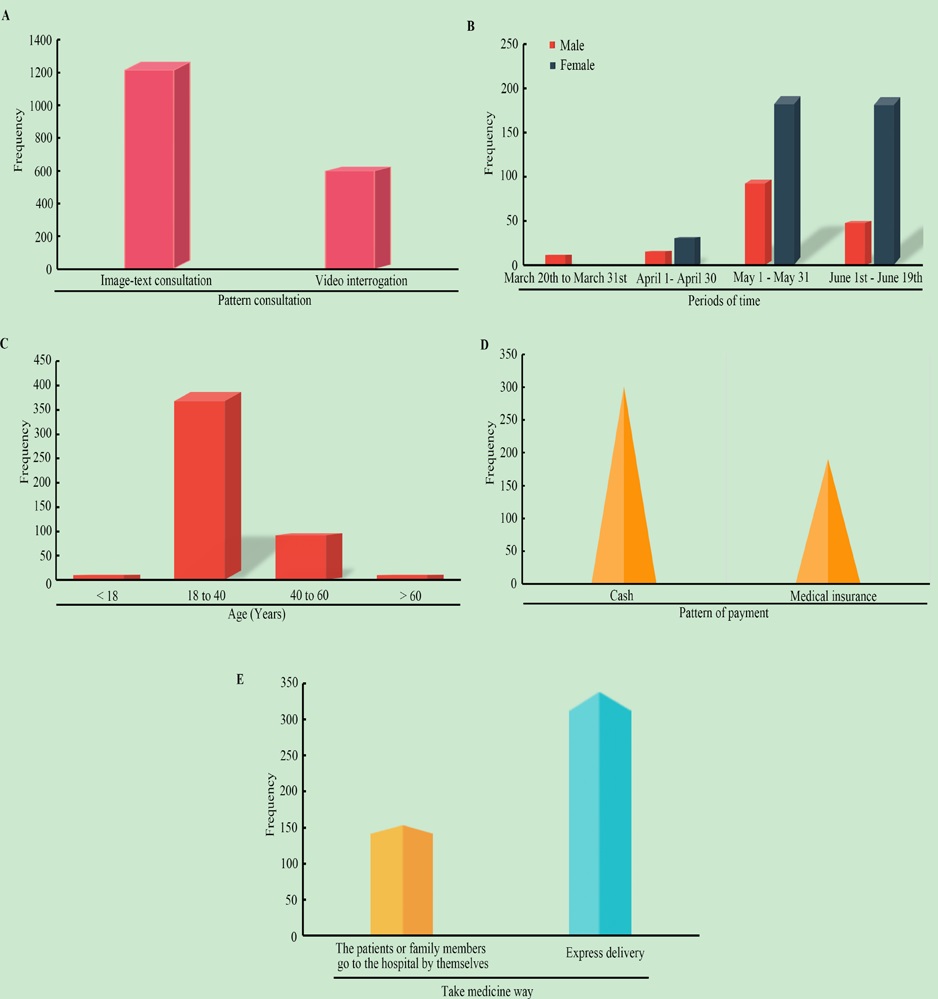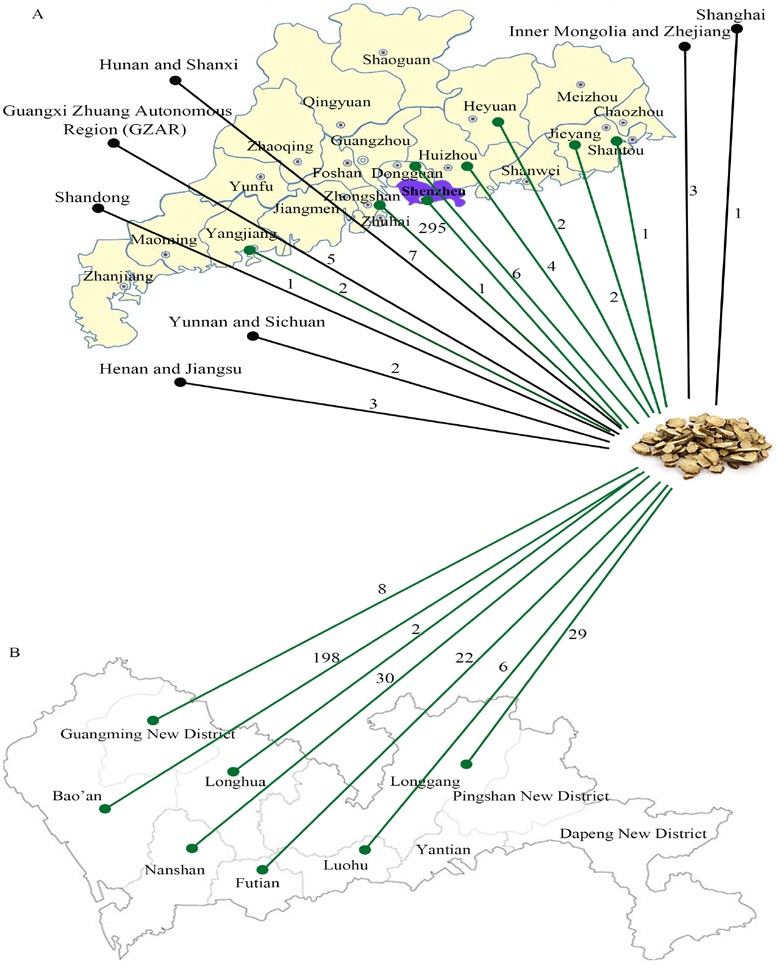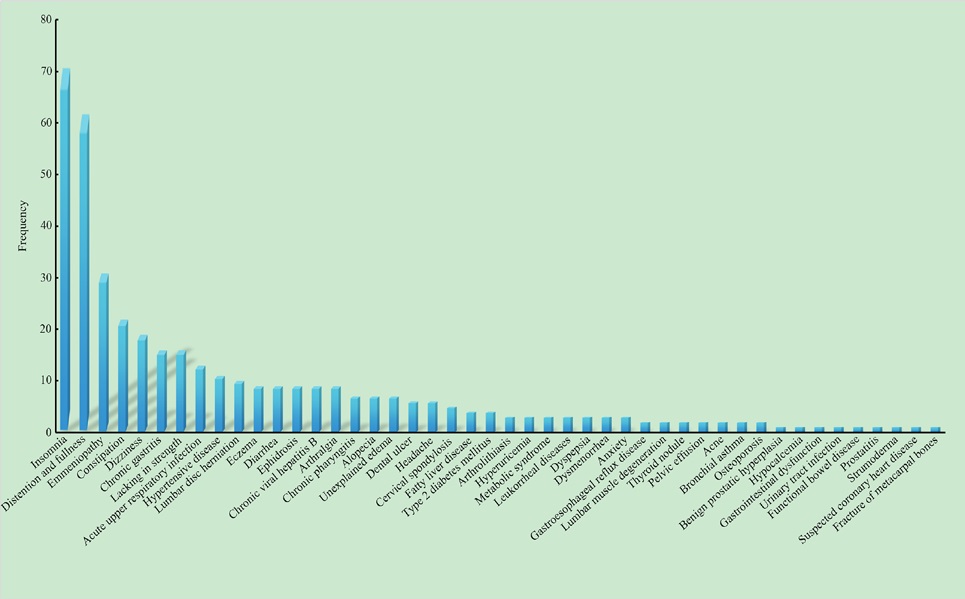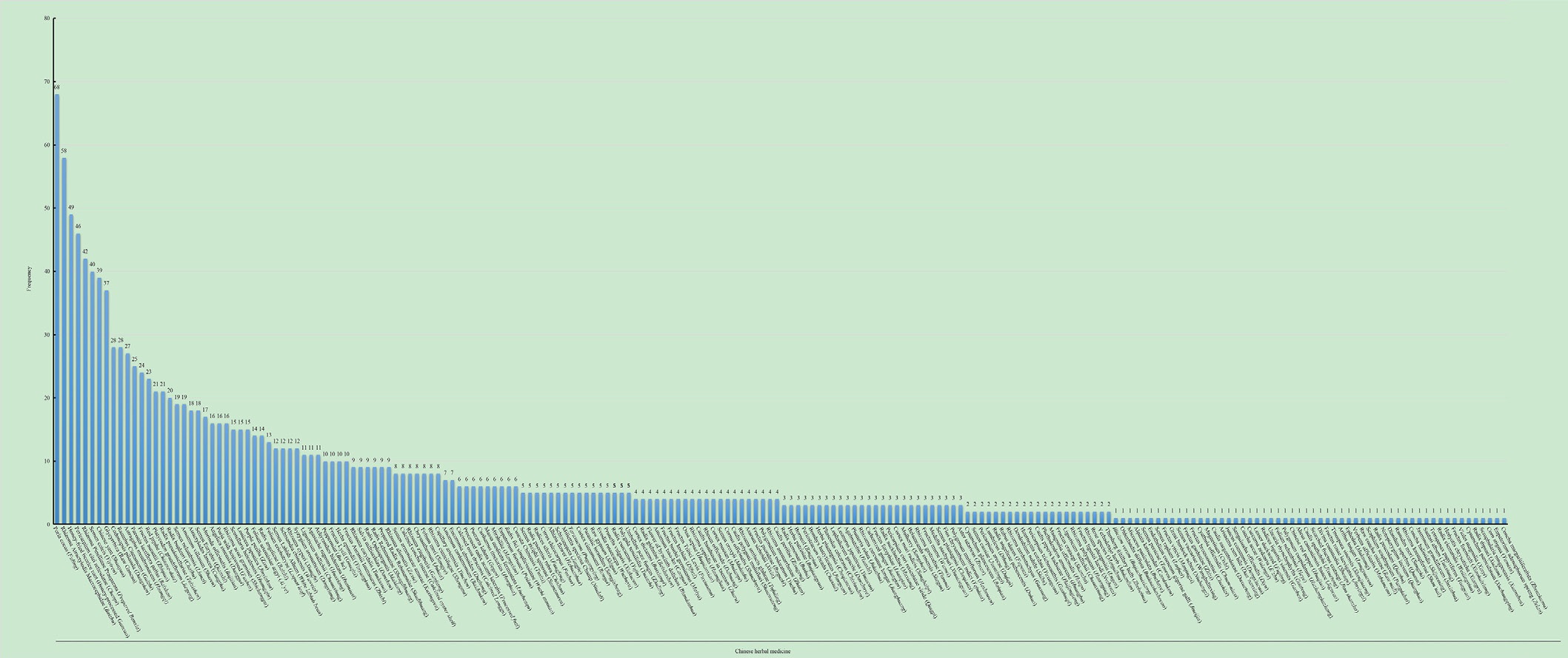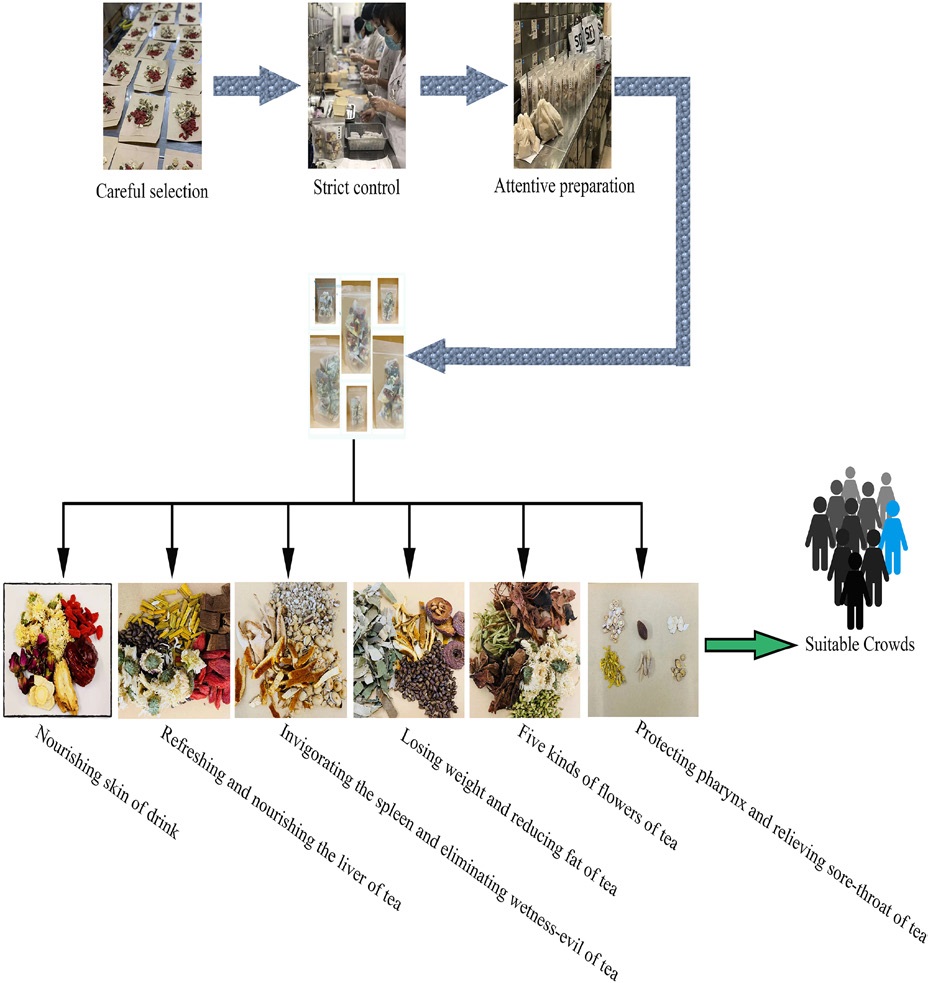
Journal of Clinical Images and Medical Case Reports
ISSN 2766-7820
Research Article - Open Access, Volume 3
The social effects and potential value of combination of Chinese herbal medicine with internet hospitals during the COVID-19 epidemic
Chao Huang; Weixuan Huang; Haosheng Liu; Zhaoxin Chen; Ying Sun; Weizeng Shen*
Department of Traditional Chinese Medicine, The Affiliated Bao’an Hospital of Shenzhen, Shenzhen, 518100, China.
*Corresponding Author: Weizeng Shen
Department of Traditional Chinese Medicine, The
Affiliated Bao’an Hospital of Shenzhen, Shenzhen,
518100, China.
Email: shenweizeng@163.com
Received : Feb 09, 2022
Accepted : Mar 15, 2022
Published : Mar 22, 2022
Archived : www.jcimcr.org
Copyright : © Shen W (2022).
Abstract
Background and objective: The diagnosis and treatment of other common and chronic diseases under circumstances of COVID-19 epidemic is very serious. This study aimed to summarize and assess the social effects and potential value of combination of Internet hospital with Chinese herbs on the patients suffering from common and chronic diseases.
Methods: We collected and evaluated daily data including manner seeing a doctor online, ages, gender, pattern of payment, and way getting the medicine. In addition, number of diseases diagnosed, areas of Chinese herbs delivered, and composition and quantity of these drugs were also computed.
Results: Physicians in Internet hospital provided online medical services to 1888 visitors daily through image-text consultation and video interrogation. The diseases included insomnia, distention and fullness, emmeniopathy. The Chinese herbs prescribed were delivered by SF-Express to Guangdong and outside, especially in Shenzhen. The prescriptions were up to 599. Six kinds of scented teas comprised by Chinese herbs were produced and extensively sold in and around Shenzhen through this Internet platform.
Conclusions: The combination of Internet hospital with TCM is very promising, contributing to control of COVID-19 epidemic and producing new industries which drive economic recovery.
Keywords: COVID-19; internet hospital; traditional chinese medicine; chronic diseases; epidemic.
Citation: Huang C, Huang W, Liu H, Chen Z, Shen W, et al. The social effects and potential value of combination of Chinese herbal medicine with internet hospitals during the COVID-19 epidemic. J Clin Images Med Case Rep. 2022; 3(3): 1751.
Introduction
Coronavirus Disease 2019 (COVID-19) caused by SARS-CoV-2 outbreaks first in China on December 2019. Unfortunately, because the virus shows the characteristics of rapid human-tohuman transmission, a total of 8,569,962 cases were confirmed and 457,388 deaths were happened worldwide as of June 20. In consequence, public’s health-related fears are also fueled, and WHO defines COVID-19 as a pandemic.
Although the epidemic situation in other countries apart from China remains extremely severe, no new native cases in China were reported till now. These hard-won achievements acquired during the anti-epidemic fight should be attributed to the highest level of public health strategies used by Chinese government. These measures include cities lockdown, traffic control, and home quarantine [1], whose purpose is to prevent the route of transmission of virus. Besides, intervention of Traditional Chinese Medicine (TCM) also plays a key function in treating the patients suffered by COVID-19. However, those mandated restrictions inevitably hamper the conventional treatments of patients with other common and chronic diseases, leading to an potential deterioration. How to solve the challenge? Fortunately, an innovative treatment model emerges in China, which is named as Internet hospitals. These hospitals have many advantages which contribute to the control of the epidemic. However, the effects of combination of TCM with Internet hospitals during the period of COVID-19 epidemic are still not reported.
Ethics approval
The study was approved by the hospital ethics committee.
Methods
Firstly, an interaction between patients and doctors needed to be established in internet-based hospital (Figure 1A). In brief, the patient who suffered any common and chronic diseases instead of emergency and severe diseases could ask his/her doctor for help by image-text consultation or video interrogation whenever and wherever possible. Then, the doctors of Traditional Chinese Medicine who were at home or in the hospital made a diagnosis based on the patient’s symptoms and signs or medical history and auxiliary examination using internet terminal. Afterwards, the doctor prescribed Chinese medicine which might boiled by themselves or our hospital. Finally, these prescribed Chinese herb medicines were delivered to the patient’s home by SF-Express.
Once the interaction between patients and doctors was accomplished, we collected and evaluated daily data from March 20, 2020, to June 19, 2020, including manner seeing a doctor online, ages, gender, pattern of payment, and way getting the medicine. In addition, number of diseases diagnosed, areas of Chinese herbs delivered, and composition and quantity of these drugs were computed (Figure 1B).
Results
Basic information of patients in internet hospital platform
As shown in Figure 2, we observed that image-text consultation and video interrogation using Internet client-side were two ways of seeing a doctor in Internet hospital, and the patients were 1265 and 623 cases (Figure 2A). We found that there were not many patients at first (March 20th to March 31st), only 13 cases (12 for male and 1 for female). The number of patients was increased at April and up to 48 cases (16 for male and 32 for female), and the patients were 180 cases (97 for male and 191 for female) at May, and 240 cases at June 1st to June 19th (Figure 2B). The youngest patient was 3 years old, and the oldest was 63 years old, but most patients are between 18 and 40 years old, followed by 40 and 60 years old (Figure 2C).
During the online medical service, our doctors gave out 599 prescriptions whose pattern of payment included cash (301 cases) and medical insurance (190 cases) (Figure 2D). Once the prescriptions were ensured and paid, the Chinese herbal medicines needed to be delivered to the patients, including two ways to get these medicines. One was that the patients or family members went to the physical hospital by themselves. The other was express delivery by SF (A domestic express company).
Area of Chinese herbs delivered by express
The delivered herbs included two forms of prescription. One was decoction prepared by hospital. The other was raw Chinese herbs and needed to be decocted by patients. These herbs were delivered to Guangdong and outside, including Guangxi Zhuang Autonomous Region, Shanxi, Hunan, Zhejiang, Inner Mongolia, and Shanghai) (Figure 3A). The number of prescription delivered to Guangdong was 316. 295 prescriptions were from Shenzhen, that of Dongguan, Huizhou and Jieyang, Yangjiang were 6, 4, and 2, 2, respectively, and all three of Shantou Yangjiang Guangzhou Zhanjiang Foshan, and Zhongshan had 1. Among districts of Shenzhen, 198 prescriptions were from Baoan, followed by Nanshan 30 and Longgang 29, 22 for Futian, 6 for Nanshan, 8 for Guangming, 6 for Luohu, and 2 for Longhua (Figure 3B).
Classification of the disease of the patients in the Internet hospital
As shown in Figure 4, most patients were suffered from common and chronic instead of emergency and severe diseases, including insomnia, distention and fullness, emmeniopathy, constipation, dizziness, chronic gastritis, lacking in strength, acute upper respiratory infection, hypertensive disease, lumbar disc herniation. Other diseases are relatively few, such as suspected coronary heart disease, fracture of metacarpal bones, strumoderma, etc.
Composition and distribution of Chinese herbs delivered
As mentioned above, the 491 prescriptions contained 207 Chinese herbs (Figure 5). The frequency of Poria cocos (Fuling) was the most (account for 68 times), followed by Rhizoma Atractylodis Macrocephalae (Baizhu), honey-fried licorice root (Zhigancao), Pericarpium citri reticulatae (Chenpi), and Rhizoma Pinellinae Praeparata (prepared Banxia).
Other TCM industries derived from the Internet-based hospitals
Summer is coming. As the temperature rises, people will increase their water intake. However, plain and dull boiled water is not their dish. Scented teas, consist of flowers and fruits of Chinese herbs, are a good choice. The palate is mellow, tasty and good-looking. Unfortunately, the quality of scented tea products on the market is uneven. How can we ensure the quality of teas? In pharmacy of Traditional Medicine, we selected fine Chinese herbs, performed strict quality control and made a careful preparation (Figure 6). Therefore, six kinds of scented teas were produced, and their names were nourishing skin of drink, refreshing and nourishing the liver of tea, invigorating the spleen and eliminating wetness-evil of tea, losing weight and reducing fat of tea, five kinds of flowers of tea, protecting pharynx and relieving sore-throat of tea, respectively. These six kinds of scented tea have their own functions and suitable for crowds (Table 1). In brief, sub-healthy people suffering from potential occupational diseases are most suitable for these scented tea. These scented teas were well received by the masses. More than 1500 packets of scented tea were sold to the whole country through our Internet hospital as of June 19, 2020.
Table 1: A brief introduction of six kinds of scented tea
Name of scented teas |
Composition |
Functions |
Suitable Crowds |
Nourishing skin of drink |
Radix Panacis Quinquefolii (Xiyangshen), Angelica sinensis(Danggui), Rose, chrysanthemum (Juhua), Red jujube (Hongzao), Lycium barbarum (Gouqi) |
Invigorating vital energy and promoting blood circulation, nourishing the liver to improve visual acuity. |
Mental worker, or office workers who spend a lot of time with their phones and computers. |
Refreshing and nourishing the liver of tea |
Dendrobium nobile (Shihu), Semen cassiae (Juemingzi), Chrysanthemum (Juhua), Lycium barbarum (Gouqi), Ganoderma lucidum (Lingzhi). |
Clearing away heat, reinforcing body fluid, and nourishing the liver and kidney. |
The people who frequently stay up late or are tired. |
Invigorating the spleen and eliminating wetness-evil of tea |
Pericarpium citri reticulatae (Chenpi), Fructus citrus sarcodactylis (Foshou), Fried semen coicis (Fried yiyiren), Fried white hyacinth bean (Fried baibiandou). |
The people whose physiques are asthenia of spleen and stagnation of wetness-evil and phlegm-wetness. |
|
Losing weight and reducing fat of tea |
Folium nelumbinis (Heye), Semen cassiae (Juemingzi), Fructus crataegi (Shanzha), Pericarpium citri reticulatae (Chenpi). |
Promoting digestion and relieving dyspepsia, promoting vital energy circulation and diuresis to eliminate the wetness-evil from the lower warmer. |
The people with obesity and dyspepsia. |
Five kinds of flowers of tea |
Lonicera japonica (Jinyinhua), Flos Sophorae (Huaihua), Common bombax flower (Mumianhua), Plumeria rubra (Jidanhua), Chrysanthemum (Juhua). |
Clearing away heat and eliminating wetness. |
The people suffering from thirst, dry cough, pharyngalgia caused by heat-evil in lung and stomach, and from abdominal pain and dysentery resulting from wetness-heat in intestinal tract. |
Radix Panacis Quinquefolii (Xiyangshen), Dendrobium nobile (Shihu), Radix ophiopogonis (Maidong), Platycodon grandiflorum (Jiegeng), Scaphium scaphigerum (Pangdahai), Glycyrrhiza (Gancao). |
Nourishing yin energy and moisturizing the lung, relieving sore-throat and eliminating sputum. |
The people with whose throats are discomfortable. |
Discussion
Gathering crowds and cross-infection are not conducive to the contact isolation and control of the COVID-19 epidemic. Furthermore, higher costs in offline clinics aggravated the financial burden on the country and the patients. Prospective, rigorous population studies and clinical practice revealed that economically inexpensive Traditional Chinese Medicine (TCM) has played crucial functions in prevention and control of 2019-nCoV epidemic [2-4]. At present, the arisen Internet Hospitals (IHs) in China play a key role in the infectious public health emergency responses and simultaneously meet the public’ s medical needs of those suffered from other illnesses [5]. In addition, potential worry of patients concerned about cross-contamination in physical hospitals would be reduced in IHs [6]. According to Haodf.com, physicians in IHs account for over 20,000 daily, acquiring considerable traction among the public [7].
The affiliated Baoan hospital of Shenzhen (the 8th People’ s hospital of Shenzhen) is the first public IH established and operated in Shenzhen and even the whole Guangdong. We predicted that combination of TCM and IH should bring more social benefits to many patients. Our IH, launched at February 1, 2020, comprehensively applies advanced technologies such as 5G, big data, artificial intelligence and blockchain. It took the lead in the establishment of nine “cloud” platforms in the city, including imaging, prescriptions, examine, pathology, electrocatdiogram and nursing. These platforms energize health service for the residents, really realizing “online appointment, offline diagnosis and treatment”. Potentially, the incorporation of TCM and IH derived from the COVID-19 epidemic situation brings about many changes in the way people are treated medically. First, the patients with common and chronic diseases don’t need to go to a physical hospital to enjoy the better quality of medical service. Second, location of clinical reception for the doctors in IHs is also flexible including physical hospital and home. In this case, an interaction between the doctors and the patients occurred through image-text consultation and video interrogation.
As soon as the IH was launched, it began to be well received by patients, for example, we have found that the patients in this IH platform were increasing month by month. Most of them are in the age group of 18 to 40 ages, followed by 40 to 60 ages. The illnesses diagnosed in the IH are mostly chronic or common diseases, including insomnia, distention and fullness, emmeniopathy, constipation, dizziness, chronic gastritis, lacking in strength, acute upper respiratory infection, hypertensive disease, lumbar disc herniation which usually needed to go to the hospital or receive treatment. So many people suffering from insomnia that more attention for them is needed. One hand, long-term insomnia may cause a decline in the body’s immunity, leading to disease susceptibility. On the other hand, whether this insomnia is caused by the anxiety of the COVID-19 epidemic and its financial burden is till a question. Correspondingly, the patterns of payment include cash and medical insurance, which can be carried out through We Chat and Paypal. Once the payment was completed, the patients need take the medicine. One manner is the patients or family members go to the hospital by themselves, which is a small percentage. The other is the express delivery by S.F. Express (a large express company in China).
The prescriptions of Chinese herbs received by patients up to 491. In these prescriptions, the frequency of usage of poria cocos (Fuling), rhizoma atractylodis macrocephalae (Baizhu), honey-fried licorice root (honey-processed Gancao), pericarpium citri reticulatae (Chenpi), rhizoma pinellinae praeparata (prepared Banxia), semen coicis (Yiyiren). These can supplement the vital energy and invigorate the spleen, promote the vital energy circulation and dissipate phlegm, refueling the patient’s recovery. For that reason and a great need for TCM, our doctor weixuan huang and colleagues have developed six kinds of tea drinks based on traditional Chinese medicine flowers (abbreviation is scented tea), as shown in Table 1. These scented teas are born according to the pathological mechanisms of these patients and to the theory of TCM, possessing different functions and suitable crowds. COVID-19 epidemic, unfortunately, has had a serious adverse impact on the global economy [8,9]. Surprisingly, Chinese Medicine is heading for clinics around the world [10]. The scented teas are a new kind of industry of TCM, promoting the economic recovery to a certain extent owing to involvement the production, management and transportation of Chinese herbs. Besides, these teas aim at sub-healthy populations suffering from potential occupational diseases; therefore, they can also improve people’s health and prevent common diseases. It is important that the scented teas in the background of IH are a great support for disease contact isolation to avoid cross-infection.
Conclusion
In conclusion, Internet hospital can be combined with TCM and this combination is very promising, contributing to control of COVID-19 epidemic and promoting economic recovery influenced by this epidemic.
Declarations
Acknowledgement: Weixuan Huang, Jingbo He, Xu Chen and Weizeng Sheng are responsible for the Internet hospital construction and publicity. Haosheng Liu, Fengxian Chen, Xi Chen, Lin Zhong, Mixia Qi, Qiong An, Juan Zeng, Qiao Lin, Zhaoxin Chen, and Ying Sun are responsible for data collection.
Funding information: This work was supported by National Natural Science Foundation of China (81903985) and Natural Science Foundation of Guangdong Province (2018A030310060).
Conflicts of interest: All authors claim no any conflicts of interest.
Impact on practice statements: The combination of Internet hospital with TCM is a novel mode of drug delivery, and can contribute to control of COVID-19 epidemic. It also produces new industries which drive economic recovery.
References
- Bao Y, Sun Y, Mseng S, Shi J, Lu L. 2019-nCoV epidemic: Address mental health care to empower society. Lancet (Lond Engl). 2020; 395: e37-e38.
- Luo H, Tang QL, Shang YX, Liang SB, Yang M, et al. Can Chinese Medicine Be Used for Prevention of Corona Virus Disease 2019 (COVID-19)? A Review of Historical Classics, Research Evidence and Current Prevention Programs. Chin J Integr Med. 2020; 26: 243-250.
- Chan KW, Wong VT, Tang SCW. COVID-19: An Update on the Epidemiological, Clinical, Preventive and Therapeutic Evidence and Guidelines of Integrative Chinese-Western Medicine for the Management of 2019 Novel Coronavirus Disease. Am J Chin Med. 2020; 48: 737-762.
- Ren JL, Zhang AH, Wang XJ. Traditional Chinese medicine for COVID-19 treatment. Pharmacol Res. 2020; 155: 104743.
- Kai Gong, Zhong Xu, Zhefeng Cai, Yuxiu Chen, Zhanxiang Wang, et al. Internet Hospitals Help Prevent and Control the Epidemic of COVID-19 in China: Multicenter User Profiling Study. J Med Internet Res. 2020; 22: e18908.
- Asmundson GJG, Taylor S. Coronaphobia: Fear and the 2019- nCoV outbreak. J Anx Disord. 2020; 70: 102196.
- Shuangyi Sun, Keting Yu, Zhen Xie, Xiaoting Pan. China Empowers Internet Hospital to Fight Against COVID-19. J Infect. 2020; 81: e67-e68.
- Ömer Açikgöz, Asli Günay. The Early Impact of the Covid-19 Pandemic on the Global and Turkish Economy. Turk J Med Sci. 2020; 50: 520-526.
- Arshad Ali S, Baloch M, Ahmed N, Arshad Ali A, Iqbal A. The Outbreak of Coronavirus Disease 2019 (COVID-19)-An Emerging Global Health Threat. J Infect Public Health. 2020; 13: 644-646.
- Cyranoski D. Why Chinese medicine is heading for clinics around the world. Nature. 2018; 561: 448-450.

